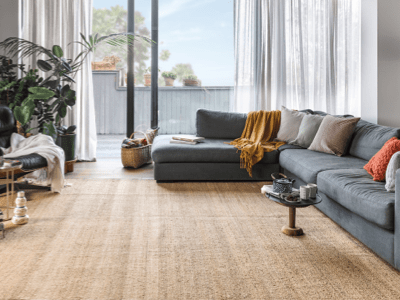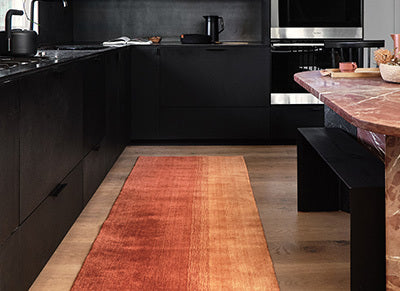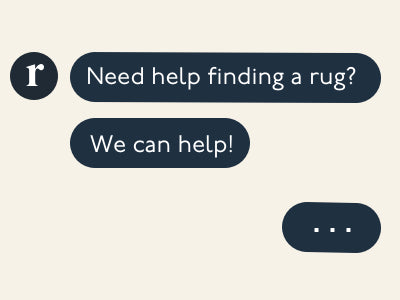














One-of-a-kind vintage rug, handwoven and handknotted by Beni Ourain tribes in the Middle Atlas mountains of Morocco
Dimensions: 6'2" x 9'10" (190 cm x 300 cm)
Bowles has been professionally cleaned; age-related wear and natural inconsistencies are inherent in these unique, handcrafted vintage rugs.
Rug Type:
-
Naturally Aged
Vintage, handwoven rugs from Turkey and Morocco, selected for their color and design and preserved as-is.
Age:
-
Vintage
Typically between 20-100 years old
Main Color:
- Beige, Cream
- One-of-a-kind vintage rug — only one in stock!
- 100% wool
- Dimensions: 6'2" x 9'10" (190 cm x 300 cm)
- Plush pile: approximately 1.2"(3cm)
- One-sided fringe: measures 1.6" (4 cm)
- Color palette: cream, warm vanilla beige, charcoal, smokey gray
- These rugs are prized for their expressive design and construction. Their freeform edges meander and wiggle, unbound by constrictions of mass production
- Moroccan rugs don’t come with a key. As with any painting or poem, their motifs have many subjective interpretations. Originally made for personal use, these rugs took months to weave, documenting a shifting tide of events and emotions in the weaver’s life.
- Directional design or color gradients with purposeful asymmetry and movement
- Artisanal and tribal, geometric designs feature angular edges and primitive shapes—like diamonds, squares, lattices, and stylized animals
- An absolute classic, diamond-based designs create a beautiful and dynamic field of geometric shapes
- Architectural elements represent significant structures like tents, minarets, and houses
As of 1991, the large Beni Ourain tribal territory was home to nearly a quarter of the Moroccan sheep population. This rather large group of tribes are famous for their fleece-like white rugs, designed for sleeping on and under, with a barely-visible meandering black or brown diamond lattice design.
Material DetailsWool, a staple in Moroccan rug design, was considered almost sacred to the Amazigh (Berber) people, whose nomadic lifestyle included sheep and goat herding. In addition to being available, wool is durable, long-lasting, and incredibly plush—so it’s super comfy to walk and relax on. In this piece, the wool pile is knotted onto a wool foundation, adding body and helping it hug the floor.
Moroccan wool is locally sourced and produces a thick, strong pile that feels soft underfoot. Having stood the test of time, this hand-processed wool has reacted to its various environments, acquiring an untamed, nubby look and feel
- Dust and dirt that accumulate in your rug can erode the fibers over time. The best way to combat this is to take your rug outside and give it a good shake once a week. Depending on how large it is, you may need to recruit a friend to help. Also, be sure to get a rug pad—this helps to preserve your rug in spite of dirt.
- If shaking it out isn’t possible, you can vacuum it instead—just be cautious, and don’t use a rotary vacuum, because it can damage the fibers. Once or twice a month, use the suction attachment gently, from side to side. Once or twice a year, flip your rug over and vacuum the back.
- Once a year, let it sunbathe. Hang it in the sun for a few hours when it’s hottest, and flip it over midway through, to expose both sides to direct sunlight. This sun-bleaching helps further sanitize the wool. It’s a natural method to bleach and deodorize it.
- To ensure equal wear and protect against walk patterns, change your rug's direction periodically. You can also flip your rug upside-down once in awhile, and use it like that for a bit. With Moroccan rugs, the back is typically as nice as the front.
- Every 3-5 years, we recommend getting your rug professionally hand-washed with a Moroccan rug expert. Please do not take it to get steam or dry cleaned—this will almost certainly damage the rug! Hand-washing requires the use of a pH-balanced shampoo, worked into the rug by hand with a soft-bristled brush, before being rinsed thoroughly. This process should be repeated a few times.
- In case of spills:
- If the spill is organic and non-oily (e.g., wine), use a paper towel or cloth to blot the liquid. Add some clean water sparingly to the spot to dilute the stain (or wet a paper towel or cloth) and blot. Repeat this process until the stain is removed.
- If the stain is persistent, resist the urge to scrub. Scrubbing can damage the wool fibers and more easily allow the stain to penetrate. You may try using a mild detergent, such as very diluted dishwashing soap, following the same blot-and-rinse procedure.
- If the spill is a denser, more oily liquid, try first to scoop what you can from the surface using a spoon or perhaps some heavier paper, and then do the blot-and-rinse. If the spill is significant, non-organic and/or composed of chemical substances, or the above methods don’t work, we suggest getting the rug professionally hand-washed as soon as possible.
- For rugs with deeply saturated color palettes, be sure to spot-clean them in an area that can be hosed down immediately after, as some color bleeding may occur.
Order A Sample
Bowles - Rug Sample
Size 12" x 12"
Free shipping & return
Recently Viewed
Bowles Vintage Beni Ourain Rug
Scaled sale up to 30% off sitewide, ends 12/2. No code needed.
![]() Free Shipping
Free Shipping
![]() Easy Returns
Easy Returns
One-of-a-kind vintage rug, handwoven and handknotted by Beni Ourain tribes in the Middle Atlas mountains of Morocco
Dimensions: 6'2" x 9'10" (190 cm x 300 cm)
Bowles has been professionally cleaned; age-related wear and natural inconsistencies are inherent in these unique, handcrafted vintage rugs.
- One-of-a-kind vintage rug — only one in stock!
- 100% wool
- Dimensions: 6'2" x 9'10" (190 cm x 300 cm)
- Plush pile: approximately 1.2"(3cm)
- One-sided fringe: measures 1.6" (4 cm)
- Color palette: cream, warm vanilla beige, charcoal, smokey gray
- These rugs are prized for their expressive design and construction. Their freeform edges meander and wiggle, unbound by constrictions of mass production
- Moroccan rugs don’t come with a key. As with any painting or poem, their motifs have many subjective interpretations. Originally made for personal use, these rugs took months to weave, documenting a shifting tide of events and emotions in the weaver’s life.
- Directional design or color gradients with purposeful asymmetry and movement
- Artisanal and tribal, geometric designs feature angular edges and primitive shapes—like diamonds, squares, lattices, and stylized animals
- An absolute classic, diamond-based designs create a beautiful and dynamic field of geometric shapes
- Architectural elements represent significant structures like tents, minarets, and houses
As of 1991, the large Beni Ourain tribal territory was home to nearly a quarter of the Moroccan sheep population. This rather large group of tribes are famous for their fleece-like white rugs, designed for sleeping on and under, with a barely-visible meandering black or brown diamond lattice design.
Material DetailsWool, a staple in Moroccan rug design, was considered almost sacred to the Amazigh (Berber) people, whose nomadic lifestyle included sheep and goat herding. In addition to being available, wool is durable, long-lasting, and incredibly plush—so it’s super comfy to walk and relax on. In this piece, the wool pile is knotted onto a wool foundation, adding body and helping it hug the floor.
Moroccan wool is locally sourced and produces a thick, strong pile that feels soft underfoot. Having stood the test of time, this hand-processed wool has reacted to its various environments, acquiring an untamed, nubby look and feel
- Dust and dirt that accumulate in your rug can erode the fibers over time. The best way to combat this is to take your rug outside and give it a good shake once a week. Depending on how large it is, you may need to recruit a friend to help. Also, be sure to get a rug pad—this helps to preserve your rug in spite of dirt.
- If shaking it out isn’t possible, you can vacuum it instead—just be cautious, and don’t use a rotary vacuum, because it can damage the fibers. Once or twice a month, use the suction attachment gently, from side to side. Once or twice a year, flip your rug over and vacuum the back.
- Once a year, let it sunbathe. Hang it in the sun for a few hours when it’s hottest, and flip it over midway through, to expose both sides to direct sunlight. This sun-bleaching helps further sanitize the wool. It’s a natural method to bleach and deodorize it.
- To ensure equal wear and protect against walk patterns, change your rug's direction periodically. You can also flip your rug upside-down once in awhile, and use it like that for a bit. With Moroccan rugs, the back is typically as nice as the front.
- Every 3-5 years, we recommend getting your rug professionally hand-washed with a Moroccan rug expert. Please do not take it to get steam or dry cleaned—this will almost certainly damage the rug! Hand-washing requires the use of a pH-balanced shampoo, worked into the rug by hand with a soft-bristled brush, before being rinsed thoroughly. This process should be repeated a few times.
- In case of spills:
- If the spill is organic and non-oily (e.g., wine), use a paper towel or cloth to blot the liquid. Add some clean water sparingly to the spot to dilute the stain (or wet a paper towel or cloth) and blot. Repeat this process until the stain is removed.
- If the stain is persistent, resist the urge to scrub. Scrubbing can damage the wool fibers and more easily allow the stain to penetrate. You may try using a mild detergent, such as very diluted dishwashing soap, following the same blot-and-rinse procedure.
- If the spill is a denser, more oily liquid, try first to scoop what you can from the surface using a spoon or perhaps some heavier paper, and then do the blot-and-rinse. If the spill is significant, non-organic and/or composed of chemical substances, or the above methods don’t work, we suggest getting the rug professionally hand-washed as soon as possible.
- For rugs with deeply saturated color palettes, be sure to spot-clean them in an area that can be hosed down immediately after, as some color bleeding may occur.






